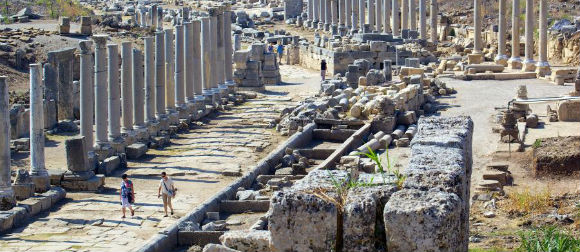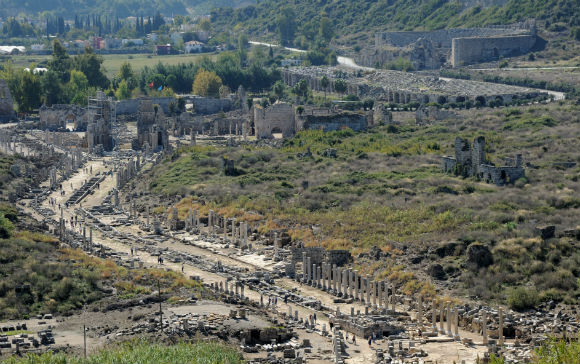The most impressive ruins of the Pamphylian coast are at Perge, at about 15 km east of Antalya. Perge was originally founded by the Hittites around 1500 BC. and was known as Parha. It was a successful trading centre near the Aksu (ancient Kestros or Cestrus) river when Alexander the Great arrived in 333 BC. He was welcomed in by the inhabitants and used Perge as base for his Anatolian campaigns. Alexander was followed by the Seleucids under whom the city prospered and Perge’s most celebrated inhabitant, the mathematician Apollonius from Perge lived and worked. Apollonius was a pupil of Archimedes and wrote a series of eight books on geometry. In 188 BC Perge became part of the Roman Empire during which the city flourished. Most of the surviving buildings date from this period.In 46 AD St. Paul started his journey in Perge (biblical Perga) and preached his first sermon here. Perge gradually declined during the Byzantine period, as the Aksu river silted, but remained inhabited until Selçuk times after which it became abandoned.
A visit to Perge starts by entering the archeological site through the Roman Gate, built during the reign of Septimius Severus (193-211 AD). Proceeding through the gate, to the right is the Agora or market place. This structure of 75 x 75 m dates back from the 2nd century AD. The center courtyard and shops were surrounded by a wide stoa, a covered walkway. The floor of the stoa and shops was made of colored mosaics. The agora was not only the centre of Perge’s trade, but was also a place for meetings as well as a forum for political, social, and philosophical discussions. The next building is the Hellenistic city gate that dates back to the 3rd century BC. This is certainly the most imposing building of the city and was cleverly designed to protect the city with its twin towers and its horseshoe-shaped courtyard at the back. It is thought that the towers had three floors and were crowned by a conical roof. In the year 121 AD, the horseshoe-shaped courtyard was rededesigned as a courtyard of honor. Behind the courtyard stood a triple arch. Around the arch there are about dozen inscriptions connected with Plancia Magna who lived in the 2nd century AD. She was the daughter of the governor, a priestess of Artemis Pergaia (Diana) and a benefactress to the city. Plancia Magna had the arch decorated with the statues of the emperors and their relatives.
After passing through the Hellenistic Gate and courtyard, one enters a broad, marble-paved double-colonnaded street measuring 300 meters in length that extends from the main gate to the acropolis. The street is 20 m wide and is divided in two by a 2 meter wide water channel running down the middle. At the end of the colonnaded street is the Nymphaeum, a triumphal fountain from where a stream flowed down into the water channel. The nymphaeum or nymphaion is an ornamental semicircular structure and dates from the reign of Emperor Hadrian (130-150 AD). A statue of a river god Kestros was located in the center of this huge fountain. Behind the nymphaeum is the acropolis with some remains of the Byzantine period. To the west of the nymphaeum are the remains of a palaestra dating from 50 AD and dedicated to the Emperor Cladius (41-54 AD).
Returning back to the entrance, there are the excavated Roman baths located southwest to the agora. Out of the site proper, is the horsehsoe-shaped stadium, the largest in Asia Minor, measuring 234 m by 34 m. The stadium had a seating capacity of 12,000 people supported by massive barrel-vaulted constructions. Just beyond the site entrance is also the theatre, which is of the Greco-Roman type and could seat 15,000 people. Unfortunately, it is for some time under reconstruction and unfortunately closed to visitors.
Perge,



liked the follow on to the amphitheatre …but could nt get excited or motivated by perges
Surprised just how large this site is and at the present time only about 10% has been excavated. Sadly the amphitheatre was closed for renovations during our visit
After seeing Ephesus, I thought it was so cool. But Perge was not bad in comparison – at least not packed like Ephesus.
The theater of Perge is closed to visit unfortunately,because of restoration.There is a stadium near the visitors' car park.You must experience walking on the main street of Perge.There is water canal at the middle of the street.At the end of the street there is an acropol nymphaeum.In ancient times water traveled the whole street through the canal from this point.
Well worth a visit its fab good tour guide learning about the ruins was fasinating. Some going back before the romans. After our. After our visit we were taken a short coach ride to a viaduct that was used bc below it you will find a small turkish market about 12 stalls they have the normal tatt along with the…
Excavations at this site by archaeologists commenced in 1946 and there has been considerable restoration, especially of the superb theatre, colonnaded street and northern nymphaeum. Be aware that some areas are closed on a regular basis for further work.
It was disheartening to talk to those involved with restoration to learn about looting with some repairs and replaced capitals stolen…
Try to gt there around 8:30 AM before the tour busses arrive and you will have the entire place to yourself, the better to imagine what life was like so long ago.
i saw many ruins but here is a real city with agora, hammams, central heating system in living places, waterways and theatre… everyone must see…
We visited the ruins of this city as part of our tour. We had a very good tour guide who spent more than an hour walking us through the ruins showing us where all the baths, shops, gates, waterways, etc were. It is certainly well worth spending time and having a good guide.
We just visited Perge, about 2km beyond Antalya's airport by car. It is a site that should not be missed while in Antalya. A great experience of seeing how this important city of Pamphylia was built and then restored by the Romans. You can easily spend 2hrs here. There are adequate signs that explain what you are looking at.